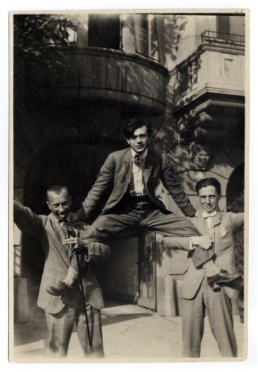Difference between revisions of "Tristan Tzara"
Sorindanut (talk | contribs) (→Links) |
Sorindanut (talk | contribs) (→Works) |
||
| Line 15: | Line 15: | ||
* ''L'arbre des voyageurs'', Éditions de la Montagne, Paris, 1930 | * ''L'arbre des voyageurs'', Éditions de la Montagne, Paris, 1930 | ||
* ''L'Homme approximatif'', Imprimerie Union par les Éditions Fourcade, Paris, 1931 | * ''L'Homme approximatif'', Imprimerie Union par les Éditions Fourcade, Paris, 1931 | ||
| + | * ''À haute flamme'', Imprimerie Jacquet, Paris, 1955 (with 5 draws by Pablo Picasso) | ||
==See also== | ==See also== | ||
Revision as of 09:37, 23 December 2013
Tristan Tzara (April 16 1896 – December 25, 1963) pseudonymous of Samuel Rosenstock, was a Romanian and French avant-garde poet, essayist and performance artist. Also active as a journalist, playwright, literary and art critic, composer and film director, he was known best for being one of the founders and central figures of the anti-establishment Dada movement.
Life and work
In 1912, still in high school, he co-founded Simbol (Symbol) magazine with Marcel Iancu and Ion Vinea with help from Iosif Iser. During this period signed with the pseudonym "S. Samyro" that will change later in "Tristan Ruia" and finally Tristan Tzara. In fact the name "Tristan" is not chosen for the particular resonance that has the name in Romanian, but because they express the mood of the "sad young poet" (writes Heinrich Stiehler in Tristan Tzara Peripheral zwischen und Zentrum).
Works
- La Première aventure céleste de Monsieur Antipyrine, Collection Dada, Zürich, 1916 (with draws by Marcel Iancu)
- Vingt-cinq poèmes, Collection Dada, Zürich, 1918 (with illustrations by Hans Arp)
- Vingt cinq poemes/ Douăzeci și cinci de poeme (Romanian trans.), Editura Vinea, Bucureşti, 1998
- Cinéma calendrier du coeur abstrait. maisons, Collection Dada, Zürich, 1920 (with illustrations by Hans Arp)
- Sept manifestes Dada, Éditions du Diorama, Paris, 1924
- Mouchoir de nuages, tragédie en 15 actes, Éditions de la galerie Simon, 1925
- Indicateur des chemins de coeur, Éditions Jeanne Bucher, Paris, 1928
- L'arbre des voyageurs, Éditions de la Montagne, Paris, 1930
- L'Homme approximatif, Imprimerie Union par les Éditions Fourcade, Paris, 1931
- À haute flamme, Imprimerie Jacquet, Paris, 1955 (with 5 draws by Pablo Picasso)
See also
Legacy
Beside the many authors who were attracted into Dada through his promotional activities, Tzara was able to influence successive generations of writers.
Literature
- Irene E. Hofman, Documents of Dada and Surrealism: Dada and Surrealist Journals in the Mary Reynolds Collection, Art Institute of Chicago, Ryerson and Burnham Libraries, 2001
